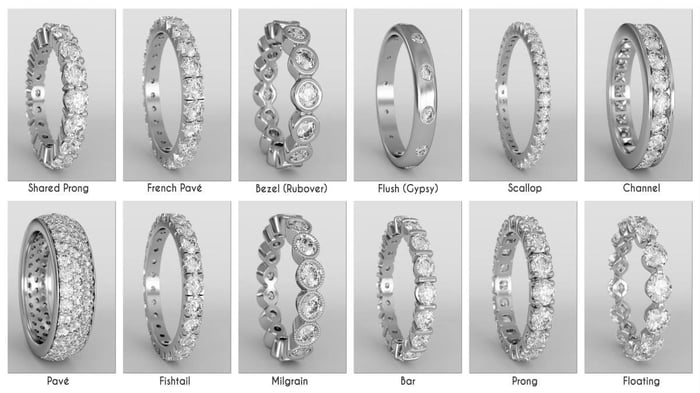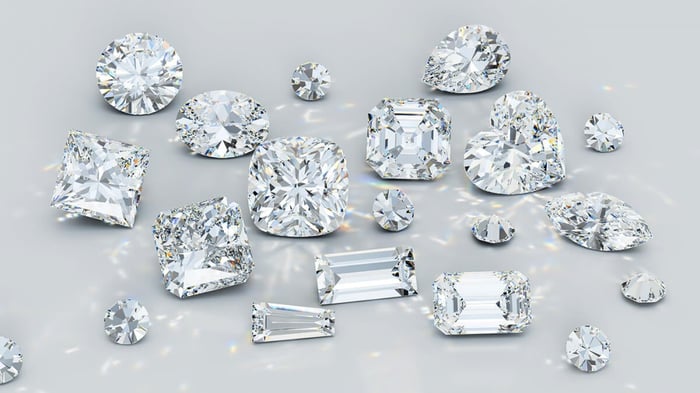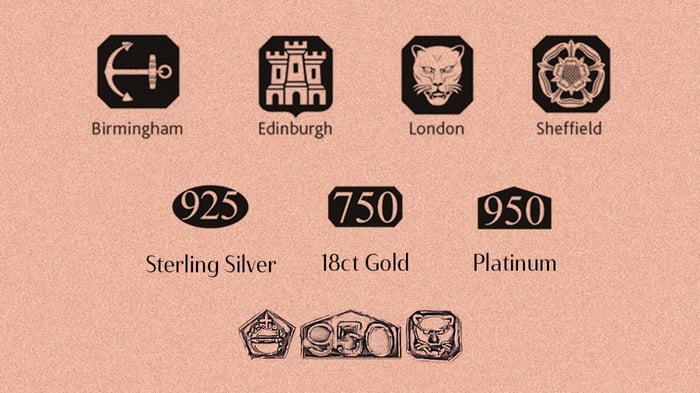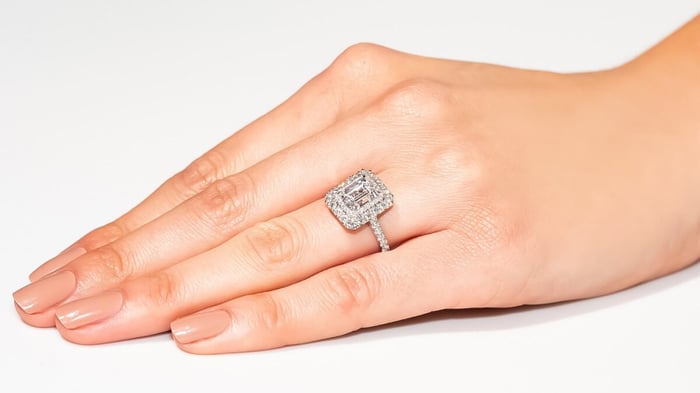All About How Gems Are Set Into Jewellery
When you choose a jewellery piece, part of the piece's beauty is how the precious metals interact with the diamonds and other precious stones the designer has chosen. The method of fixing a stone to the metal that holds and displays it is called the jewellery's ‘setting’.
Not only does the setting serve to hold the gemstones firmly in place, but it also influences the appearance of the precious stones and the overall look of the piece.
The method of setting the stone affects the durability of the jewellery meaning that a ring that is to be worn daily such as an engagement ring needs to have a durable setting that will not easily allow the precious diamonds to be lost. At the same time, the designer knows that the wearer wants to enjoy all the beauty of the diamonds and so must make a compromise between appearance and durability. That is just one reason why buyers of jewellery are usually advised to return the ring or other items to the jeweller for periodic maintenance. At this time, any loose gems can be re-fixed and settings repaired for future long service.
There are many kinds of jewellery setting used by jewellery designers and manufactures; this piece covers the ones that are most likely to be seen in modern jewellery.
The Types Of Setting Most Often Found In Jewellery
Claw Setting (Prong Setting)
The claw setting is possibly the most commonly seen setting type in engagement rings. The setting allows light to enter the bottom of the diamond. The light makes the gem sparkle more brilliantly as it passes from the diamond's sides and base up and out of the facets and face when it is looked at.
Claw, or sometimes prong, setting uses small metal claws soldered to the ring and then curved over the gem's edges to hold it firmly in place. This allows most of the diamond to be seen, rather than being hidden behind the metal.
0.50ct Classic Claw Set Diamond Cross Pendant in 18K White Gold
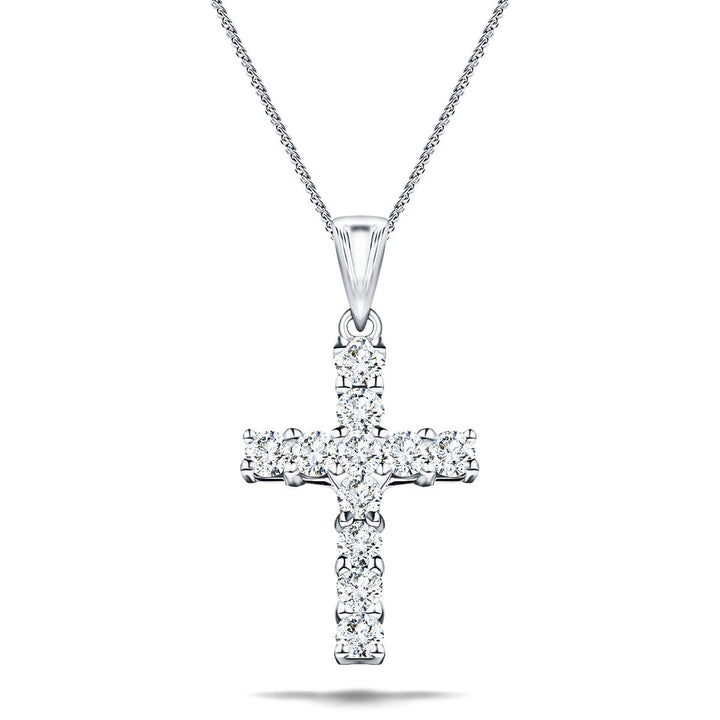
$1,102.00
$1,706.00
This classic claw set diamond cross pendant is a truly beautiful piece that sparkles on the neckline. With half a carat and G/SI quality of sustainable diamonds in fine 18k white gold, it makes the perfect, ethical luxury gift for… read more
Over time, regular knocks and wear can cause the prongs to loosen and, eventually, the diamond may become loose. For this reason, rings, in particular, are often regularly serviced by jewellers. The claws are reshaped and sometimes replaced to ensure the security of the diamonds they hold.
Most shapes of diamonds and other stones can be held with a claw or prong setting; it makes the most of the gems it holds due to the high position and open sides allowing the maximum amount of light to pass.
Claw settings are often found in all types of jewellery but are often favoured in engagement and wedding rings. Claw settings are often combined with pave settings with smaller diamonds.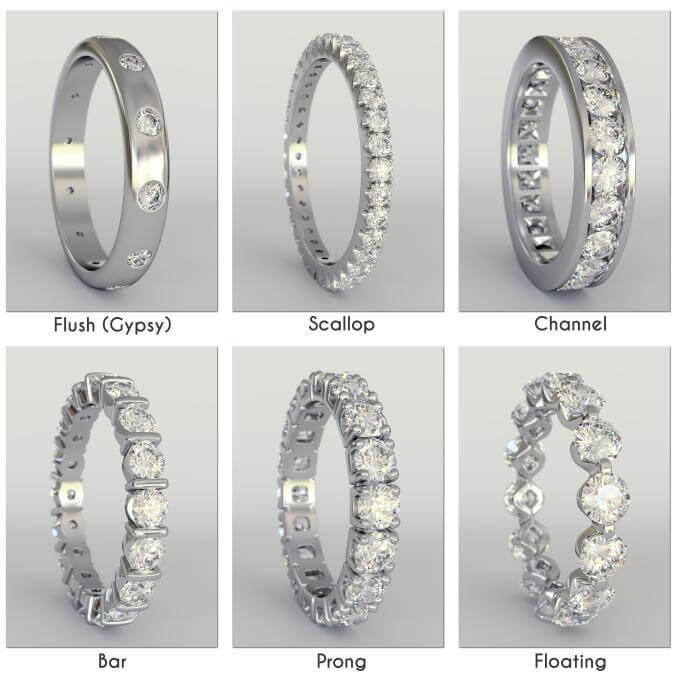
Pave Setting
Pave setting is derived from the French word for 'paved'. In this jewellery setting style, several small stones are combined, in a similar way to cobblestones, with only a tiny amount of precious metal visible between each gemstone. The effect is to give the impression and sparkle of a larger stone.
The diamonds are held in place and separated from each other with tiny beads of metal used in the setting.
Pave setting is often used with other setting types such as a claw to hold a larger diamond and a field of small pave set stones on the ring's shoulders. This blend of setting types can give a very effective visual display.
Pave settings suit stones cut in emerald, baguette, round, square, and emerald shapes; it is a versatile setting.
Because the gemstones are placed very close to each other, resizing rings can be a tricky task and with some designs may be impossible.
 Bezel Setting
Bezel Setting
Bezel settings are probably the oldest method of setting gemstones into metal. In this technique, a narrow metal lip is formed around the shape of the stone. The lip is then permanently fused to the metal of the jewellery.
In some designs the bezel is not complete around the entire stone, this is called a semi-bezel setting. A semi-bezel setting is appropriate where the jewellery piece is not subject to hard impacts. Some jewellers refer to a semi-bezel setting as a rubover. In this case, the gemstone might appear to be slightly recessed into the metal rather than standing proud of it.
All shapes of stones can be mounted using a bezel setting, although it is most commonly found in oval and round gems. This because setting a bezel around a shape with corners and angles is a tricky and time-consuming process.
Bezel settings are robust and can withstand knocks and impacts that would loosen stones in other settings. The downside is that the stone will not show much brilliance as only the stone's top is visible, reducing the internal reflection that gives gems their sparkle.
Channel Setting
Channel settings give the appearance of the stones being set in a groove of precious metal. This setting can allow gems to show good brilliance, but it requires stones with well-cut pavilions (the part of the diamond below the widest part of the stone.
Channel Set Diamond Bangle 0.60ct G/SI Diamond in 18k White Gold
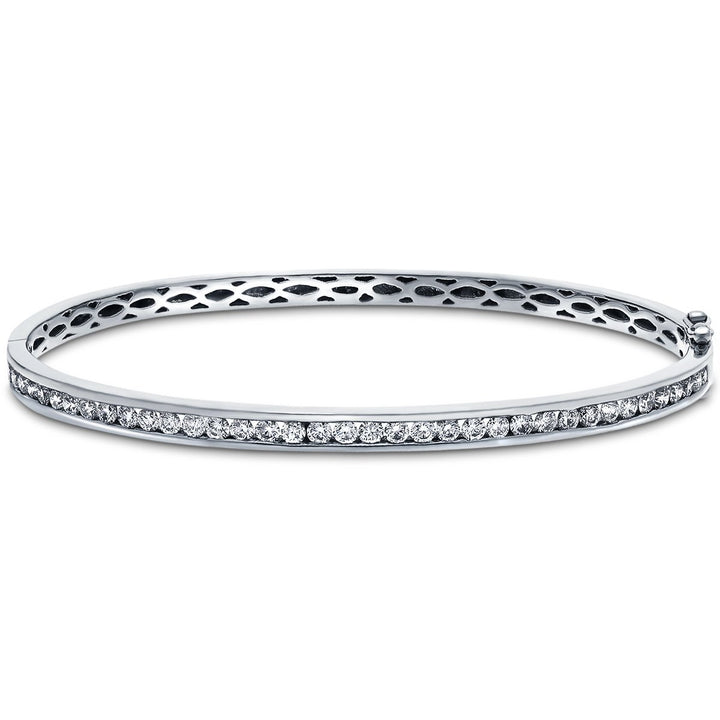
$3,272.00
$4,836.00
This elegantly handcrafted and UK hallmarked diamond bangle is a must-have accessory for any stylish jewellery collection. Over half a carat of ethically sourced G/SI quality diamonds is placed within a channel set design that elevates the look and feel… read more
Typically used to set small stones of the same size, channel settings are used in modern jewellery with most diamond shapes including round and square cuts. Rectangular and square-cut stones are particularly striking because there is no metal between each stone, giving a brilliant display as light catches the gems.
Most often seen in wedding bands with a girdle of diamonds, especially in white gold and tennis bracelets.
Countersunk Setting
A countersunk setting can look spectacular. In this style, a seat of exactly matching size and shape is formed in the ring's precious metal. The stone is slipped into the seat, and the precious metal is smoothed over the edges to create a neat edge, called a verge so that the stone and metal can appear to be one.
This setting can be very effective on rings, giving a robust and durable mount.
When you choose your jewellery, you will usually be buying the ring ready-made or according to a previously designed style so you will probably not be matching individual gems into a setting of your choice. This does not mean that you cannot choose the jewellery setting. Choose a ring, earrings, necklace, etc. with diamonds and other gems you like, the precious metal you want and the setting style you prefer. There are plenty of choices! Be guided by the jeweller's advice in terms of durability and care. Please do not choose a piece of jewellery that looks great but is not practical for the use to which it will be put.
At All Diamond, our jewellery is all designed in the UK, and you can even order custom or customised pieces. That means the choice of the best jewellery for you and your loved one is really is yours!
